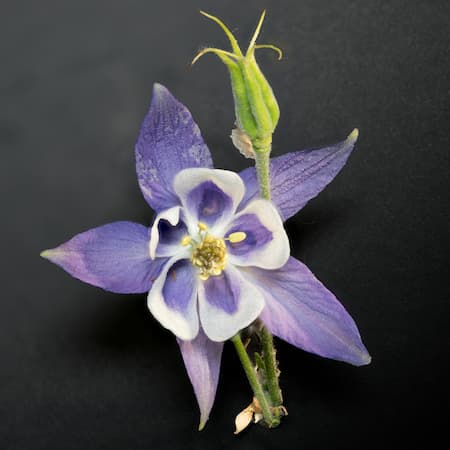How to Grow Columbine Plants

About Growing Columbine Flowers in Your Home Garden
Columbine is an easy-to-grow plant. Hardy perennial Columbine plants are native to Asia, Europe, and North America. If you are a hummingbird lover, growing Columbine is for you. It is a favorite of hummingbirds and bees because the flowers contain lots of nectar.
Columbines produce large, showy blooms of single and bicolor patterns on airy plants with blue-green foliage from late spring to early summer. The plants are short-lived perennials. However, they are very good re-seeders.
The plants grow well in flower beds, containers, as edging, and in rock gardens.
Did you Know? Columbine is the state flower of Colorado. They are also called the “Rocky Mountain Columbine”. They can be found almost to the timberline of the Rocky Mountains.
Columbine Plant Specifications
Flower Colors: Many people think of purple Columbine flowers. However, there are several other colors. Colors include shades of yellow, white, pink, blue, purple, and combinations.
Flowers Bloom: Spring to summer.
Plant Height: 18″ – 3o
Light Requirements: Partial shade to full sun.
Ideal Soil pH: 6.0 – 7.0.
Hardiness Zone: 3 – 9.
Toxicity: This plant is toxic to people and pets.
Native To: Europe, North America.
Plant Type: Perennial
Botanical Name: Aquilegia hybrida
Other Names: Culverwort, European Crowfeet, European Columbine, Granny’s Bonnet, Granny’s Nightcap.
Popular Varieties: McKana’s Giant, Tequila Sunrise
Are Columbine Plants Edible?
NO and YES!!
We state “NO” first, because it is important to be aware that the Columbine plant is poisonous to humans, pets, and livestock. The toxin in the plant can cause gastroenteritis and heart palpitations.
However, the nectar of the Columbine flower is safe to consume. It has a sweet flavor. The flowers are also edible. Try them in salads.
Important: We caution you to learn more before sampling the nectar and flowers of this otherwise toxic plant. It is always best to err on the side of caution when considering the consumption of a plant you’ve never tried before.
Medicinal Applications for Columbine Plants
While Columbie plants are toxic, there are numerous medicinal uses. Here are some of them:
- Eases some respiratory ailments.
- It improves digestion.
- Use it to treat skin afflictions.
- It reduces pain and eases headaches.
- Reduce anxiety and stress.
- It boosts the immunity system.
Light Requirements
In hot areas of the country, grow Columbines in partial shade. Select a planting location that has light, filtered sunlight, or afternoon shade for the hot sun. They will benefit from a little shade. In cooler regions of the country, they grow well in partial shade or full sun.
Perennial Columbine Flower Propagation
Columbine flowers are grown from seed. Columbine seeds can be directly seeded into your flower garden. Whether starting plants indoors for later transplant, or directly into your garden, they need sunlight to germinate.
Sow Columbine seeds in the spring and cover lightly with 1/8″ soil. Space seeds or seedlings 16-18″ apart.
Garden Note: When growing from seed, it may take two years before you see the first flower blooms. But, it is well worth the wait.
If you have established plants, Columbine can also be separated by division in the spring.
Days to Germination: 8 – 15 days.
Did You Know? The word Columbine comes from the Latin word for Dove.
How to Grow Perennial Columbine Flowers
Columbine is very easy to grow. They grow well in partial shade to full sun.
The plants grow well in average, well-drained soil. They tolerate dry soil conditions. Mix in a layer of compost at planting time, especially if the soil is poor. Plant them with the crown of the plant at the soil level.
As with many other plants, keep the soil moist, not wet. Allow the soil to dry slightly between watering. Then, water deeply for established plants.
Add a general-purpose fertilizer once a month during the growing season.
Keep the plants weeded, especially when young.
Plant Spacing: Space plants 1 to 2 feet apart. They tolerate a little crowding.
Garden Tip: Deadhead blooms to promote new flowers.
Once your Columbine plants are established, they will grow well and bloom until frost. Being very hardy, they will likely survive the first light frosts before going dormant for the winter. They do not require mulching or protection in the winter.
How to Prune Columbine Plants
Remove any dead, or diseased plants and stems.
Deadhead spent flower blooms. It makes the plant look more attractive. And it encourages the plant to produce more flower bulbs.
More on deadheading spent flower blooms.
After the flowers have bloomed, give the plant a good trim. Cut the plant back about halfway. The plant will respond by producing new stems. It will look more attractive in your flowerbed. And, those stems may result in a second flush of flowers later in the season.
Insects and Plant Disease
Columbine plants are resistant to insects and disease. If insect or disease problems occur, treat problems early with organic or chemical insect repellents and fungicides.
Also see: Plant Problems – causes and cures.
Overwintering Plants
As a cool weather perennial, Columbine overwinters quite well in colder regions of the country. After the first killing frost in the Fall, the plants die off. Cut the plant to the ground. Then, apply a thick layer of mulch to protect the root system from deep, hard freezes.
The plant will awaken again in the spring as the soil warms.
Related Articles
People who read this article will also like:
How to Grow Columbine Plants – by Garden Hobbies
Please support our site. Shop for:
- rmmatthews100@hotmail.com
- 585-721-6528
- Rochester, NY
©1999-2024 GardenersNet.Com, All Rights Reserved

